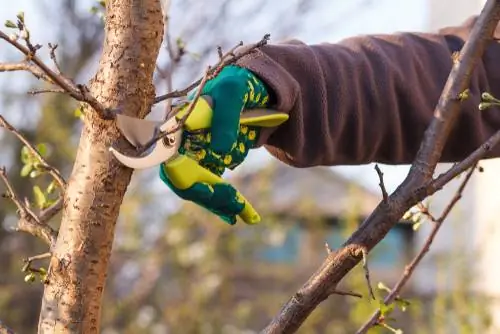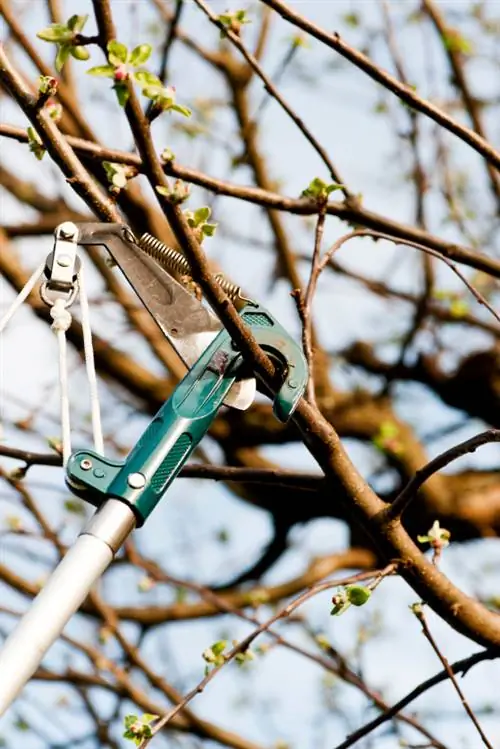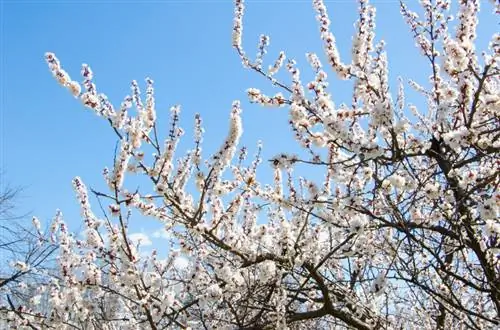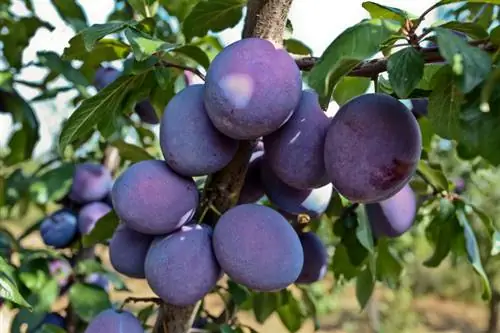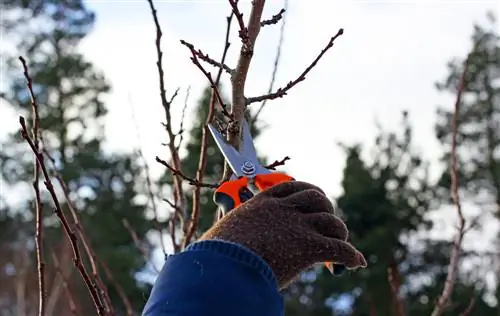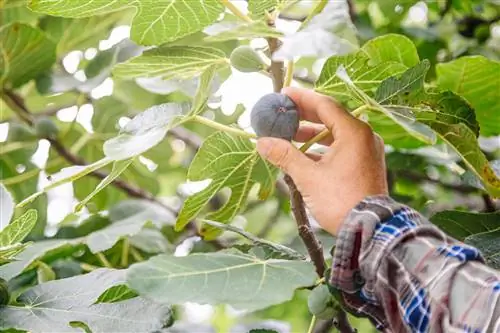- Author admin [email protected].
- Public 2023-12-16 16:46.
- Last modified 2025-06-01 06:02.
Regular cutting is important for a plum tree so that its fruit wood remains young and productive. This recommendation applies equally to Prunus domestica and its seductive subspecies, such as plums, mirabelle plums and reindeer plums. In this tutorial you will learn everything you need to know about the different types of cuts with lots of tips and tricks.
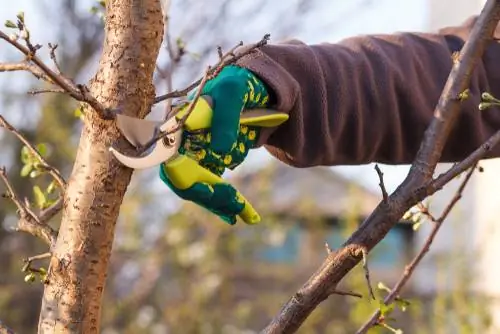
How do I prune a plum tree correctly?
To properly prune a plum tree, carry out maintenance pruning every 1 to 2 years, removing excess shoots, shortening leading branches to the optimal height and targeting the young fruiting wood. Planting, training and rejuvenation cuts also help to build a he althy crown and a rich harvest.
Fruit wood on the plum tree
A plum tree has the most productive fruit wood on itstwo- and three-year-old branches Under ideal site conditions, a shoot remains vital and blooming for up to four years. After four to five years, the fruit wood of plums, renecludes and mirabelle plums is exhausted. At this point, the aging branches in the rear area have fresh, two-year-old side shoots to offer. Gardeners don't miss this opportunity and divert the old wood to the vital offspring. Once the yield phase begins, annual maintenance pruning is beneficial in order to clear the way for new fruit wood.
Cutting types and dates
Although a plum tree can live up to 50 to 100 years, its fruit wood ages after just three to four years. The fruit tree will give you a lush harvest of juicy, sweet plums, reindeer plums and mirabelle plums if you cut it every one to two years. The following overview summarizes the types of pruning you can use to build and maintain a magnificently blooming and productive plum tree:
| Cut style | Goal/Occasion | best date |
|---|---|---|
| Plant cutting | build a productive crown framework | Spring |
| Educational Cut | create perfect crown shape | Late autumn or winter of the first 2 to 3 years |
| Conservation cut | vital fruit wood and ideal crown shape preserved | time with the harvest or in autumn after the leaves fall |
| Rejuvenation cut | revitalize old plum tree | between October 1st and February 28th |
Prologue of pruning care - plant pruning
The cutting technique for productive crown formation takes placein spring after planting. If you planted your plum tree in autumn, postpone the pruning care until a frost-free day in February or March. This is how you complete an exemplary planting cut on plums, renecludes and mirabelle plums:
- Designate the strongest shoot as the middle shoot with three to four evenly arranged leading branches
- Remove excess shoots or cut back to 10 cm
- Short strong leading branches by a third
- Prune weakly growing leading branches by half
- Place scissors over an outward-facing eye
You have done everything right when cutting the plant if at the end the tip buds of the three to four leading branches are at the same height, in the so-called juice balance. This does not apply to the dominant central shoot. Its tip bud towers over the juice scale by 15 to 20 centimeters.
Excursus
Note scatter and angle of approach of leading branches
Beginners in plum tree pruning fall victim to two common mistakes when pruning. In order for a stable crown to form, the leading branches on the central shoot must be arranged in a balanced distribution. Specifically, this means that thestarting points should be at different heights. Furthermore, the angle to the central shoot must not be too steep. A well-positioned guide branch is at an angle of between 45° and 90° to the trunk, ideally at a 60° angle. A shoot that is too steep is splayed to the correct angle. If the branches are too flat, tie them up with a string.
Treating the plum tree crown to be productive
Plum trees naturally form a narrow, upright crown. The growth is characterized by numerous steep shoots that compete with the central shoot and shade valuable fruit wood. So that plums, plums and mirabelle plums absorb a lot of sunlight and develop a full aroma, pruning care in the first few years is dedicated to beneficial crown training. The training should be completed by the time the yield phase begins after two or three years. How to do it correctly:
- The best time is after the leaves have fallen in autumn or winter on a frost-free day
- Leave a maximum of 8 outward-facing side shoots per leading branch as future fruit wood
- Cut this year's growth by a third or half
- Intersection point is 5 mm above an outward-facing bud
- Cut back all remaining side branches to 5 to 10 cm
The danger of steeply upward competitive instincts should not be underestimated. Above all, so-called slotted branches impaired the stability within the crown. Harvesting accidents are often due to a branch breaking off. So stay on the heels of steep shoots right from the start and remove the danger from the crown. If a steep shoot is in a very favorable position, tie the wood with string at an advantageous angle of 60°. The inclined position reduces the sap pressure, whereupon flower buds and fruits form.

The optimal crown shape on the plum tree consists of a dominant central shoot and three to four evenly distributed leading branches. Infertile, disruptive steep shoots are consistently removed. The buds of the leading branches should be in sap level. The tip bud on the central shoot towers 15 to 20 centimeters above the side branches.
Preserve vital fruit wood
A plum tree in the yield phase benefits from maintenance pruning every one to two years. Gardeners like to associate pruning with the plum harvest because at this point in time, the fruit wood that has been removed can be clearly seen. The crown appears clearer after the leaves have fallen in autumn or winter. The greatest treasure in the plum tree is two- and three-year-old fruit shoots. These can be easily identified by the spherical flower buds that are already planted during the current season. In contrast, shoots and leaf buds have a narrow, elongated shape. How to prune with gardening expertise:
- Cut back prominently hanging fruit shoots to a two-year-old side shoot with flower buds
- Strongly growing fruit shoots as competition for the main branch should be shortened to 10 cm cones
- Prune steep shoots, stunted branches directed towards the inside of the crown to 5 to 10 cm
- Massively branched leading branches with broom-like tips are slimmed down by a derivation cut
This year's unbranched young shoots are treated with caution. In the rarest of cases, flower buds can already be found here. Cut a branch that is more than 20 centimeters long back by a third until just before an outward-facing bud. Shorter young shoots remain uncut.

Unfavorable and dead branches are removed to short cones. Older fruit wood that has been removed several times leads to a young, outward-facing side branch that already has flower buds.
Tip
A plum tree sprouts numerous shoots of water from spring to autumn. The vertical shoots form from the rootstock of the wild rootstock, below the crown or on the tops of the leading branches. As long as the unwanted shoots are in the unwoody stage, they should be removed. Either tear off a water shoot or cut off the shoot just before the bark.
Rejuvenation treatment for old plum tree
Without annual maintenance pruning, a plum tree will be exhausted within a few years. Since the young fruit wood is blocked from access to sunlight, the crown becomes bare inside. The outer branches are characterized by massive branching, the weight of which pulls the wood towards the ground. With a rejuvenation cut you can turn back the wheel of time. This applies under the premise ofreserved cutting style The diameter of old branches to be removed should not be more than half the diameter of the leading branch or trunk. How to properly rejuvenate an old plum tree:
- The best time is between October 1st and March 1st in frost-free weather
- First remove steep shoots with an angle of less than 45° to the trunk or central shoot
- Cut out dead, inwardly growing, crossing or rubbing branches
- Cut branches more than 5 cm thick to 10 cm long cones
- Overhanging branches lead to an internal, two-year-old side shoot
- Cut back massively branched old shoots without young side shoots to 10 cm short cones
- Do not intersect sloping, horizontal, unbranched young shoots
In the professional rejuvenation of plum trees, derivation pruning plays a key role. Basically, plums, renecludes and mirabelle plums do not respond well to radical pruning. You can successfully mitigate the effects by redirecting old shoots to a young, outward-facing side shoot. Ideally it is two-year-old wood decorated with flower buds. Use pruning shears or a saw where old and young wood fork. Do not cut into the young shoot, but into the old wood a few millimeters behind the fork.
Background
Carefully cut old wood with a tenon cut
One of the most advantageous pruning techniques for pruning fruit trees is cone pruning. On plum trees, old wood tends to dry out deeply in larger cuts. This increases the risk of fungal infections and rot. By cutting a thick, old branch into tenons, you avoid the dilemma. Leave a 10 to 15 centimeter long stub. Smooth the wound with a knife and apply tree wax to the edges of the wound. In the following 2 to 3 years, young shoots will form at the base of the cone. This is the signal to remove the last remaining cones in the summer. Thanks to this procedure, your plum tree can close the wound better and faster.
Frequently asked questions
Are plum trees self-fertile?
Plums generally thrive as self-fruitful trees. Some historical varieties, however, rely on a pollinator. When purchasing from a tree nursery or garden center, ask carefully. In principle, it is advantageous for the crop yield if two plum varieties are in close proximity. If there is not enough space, this can also be a columnar plum.
At the end of March I planted my first plum tree. Is it really necessary to carry out a training cut this spring?
In fact, it is advisable to prune a plum tree in the first spring. The tree is well positioned for a high yield with a central shoot and up to four leading branches that are at an advantageous 60° angle to the trunk. Excess shoots are removed. Then shorten the scaffold shoots by half so that they are in the sap balance. Leave the middle shoot a little higher. It is important to note that the buds of the leading branches point outwards.
I would like to plant a grafted reindeer tree in the garden. Should the processing center be above or below ground?
The grafting point on the reindeer tree always remains above ground. With all plum trees for the home garden, there is a risk that the noble variety will take root on its own. In this way, the good properties of the base are lost.
Is it possible to limit a mirabelle plum tree to a height of 2 meters?
Mirabelles are - like all plum trees - a stone fruit. These fruit trees are characterized by strong growth towards light. As a result, mirabelle plum trees grow quite tall. Well-planned training and regular pruning help control growth. However, a growth height of at least 2, 50 to 3 meters is realistic. If there is a lack of space in the garden, it is advisable to cultivate mirabelle plums as columnar fruit.
I underestimated the strong growth of a plum tree and would like to transplant it. When is the best time? What should I pay particular attention to?
It is easily possible to transplant a plum tree within the first five years of existence. The best time is in autumn, when harvest and leaf fall are complete. Dig up the root ball as widely as possible. There should not have been any plums, renecludes or mirabelle plums at the new location, otherwise there is a risk of soil fatigue. A plum tree will cope better with the change of location if you cut back the crown by a third or half before or after. In this way you will make up for the lost root mass.
The 3 most common cutting mistakes
If a young plum tree consistently refuses to produce picturesque blossoms and juicy fruits or if rejuvenation results in total failure, the gardener has made typical pruning mistakes. In order to protect the readers of this tutorial from classic mistakes, the following overview draws attention to common mistakes and gives tips on how to prevent the nuisance:
| Cutting errors | malicious image | Prevention |
|---|---|---|
| no parenting cut | dense, tightly upright crown without flowers or fruits | train with central shoot and 4 leading branches at an ideal 60° angle |
| never cut | premature senescence, exhausted fruit wood, low yield | prune every 1 to 2 years and rejuvenate fruit wood |
| old plum tree radically cut back | Spread of wood rot, total failure | moderately rejuvenate through derivation or tenon cutting |

Tip
Recommendations for a rejuvenating cut in summer fall on deaf ears among responsible home gardeners. The dense crown of the old plum tree is very busy during the warm season. Hard-working parent birds like to build their nests under the protection of the leaves in order to devote themselves to raising their offspring. Radical cutting measures would have fatal consequences for the already highly threatened birdlife. The Federal Nature Conservation Act emphasizes the demand for a grace period with paragraph 39. Between March 1st and September 30th, all types of tree pruning are prohibited.

